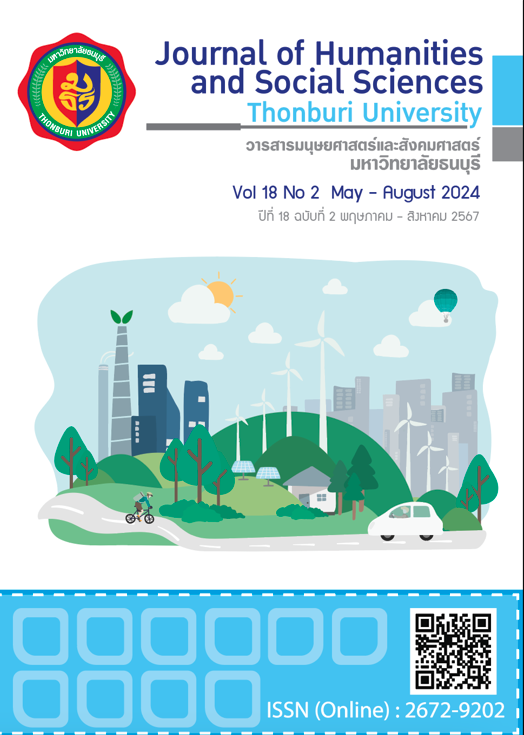ปัจจัยจิตสังคมของพฤติกรรมการมีวินัยในการเรียนในนักศึกษาปริญญาตรี
Main Article Content
บทคัดย่อ
งานวิจัยนี้มีจุดมุ่งหมายเพื่อศึกษาว่าปัจจัยทางจิตลักษณะเดิม สถานการณ์ และจิตลักษณะตามสถานการณ์ สามารถทำนายพฤติกรรมการมีวินัยในการเรียนได้ในปริมาณเท่าใด มีปัจจัยใดเป็นตัวทำนายที่สำคัญในกลุ่มรวมและกลุ่มย่อยต่างๆ ที่แบ่งตามชีวสังคมของนักศึกษา และเพื่อบ่งชี้นักศึกษาที่จะเป็นกลุ่มเสี่ยงที่มีพฤติกรรมการมีวินัยในการเรียนในปริมาณที่น้อย กลุ่มตัวอย่างเป็นนักศึกษาระดับปริญญาตรีที่มีอายุตั้งแต่ 18 ปีขึ้นไป จากมหาวิทยาลัยทั้ง 4 ภูมิภาค คำนวณกลุ่มตัวอย่างด้วยวิธีการ G*Power กำหนดค่า effect size เท่ากับ .03 ค่าความคลาดเคลื่อนเท่ากับ .05 ค่า power เท่ากับ .80 รวมตัวอย่างในงานวิจัยนี้จำนวนทั้งสิ้น 632 คน ใช้การสุ่มแบบหลายขั้นตอน (Multi-stage random sampling) สถิติที่ใช้ในการวิเคราะห์ข้อมูล ได้แก่ การวิเคราะห์สัมประสิทธิ์สหสัมพันธ์แบบเพียร์สัน การวิเคราะห์การถดถอยพหุคูณ และการวิเคราะห์ความแปรปรวนแบบสามทาง ผลการวิจัยพบว่า (1) ผลการทำนายพฤติกรรมการมีวินัยในการเรียน โดยใช้จิตลักษณะเดิม สถานการณ์ และจิตลักษณะตามสถานการณ์เป็นตัวทำนาย เมื่อใช้ตัวทำนายจากกลุ่มจิตลักษณะเดิม กลุ่มสถานการณ์ และกลุ่มจิตลักษณะตามสถานการณ์ รวม 9 ตัวแปร สามารถทำนายพฤติกรรมการมีวินัยในการเรียน ด้วยวิธี Enter ได้ 45.65% เมื่อทำการวิเคราะห์ถดถอยพหุคูณ แบบ Stepwise ปรากฏว่าในโมเดลสุดท้ายมีตัวทำนายสำคัญของพฤติกรรมการมีวินัยในการเรียนในกลุ่มรวม เรียงลำดับตัวทำนายจากมากไปน้อย ได้แก่ ทัศนคติต่อการมีวินัยในตนเอง ทักษะการบริหารจัดการตน และการคิดเปลี่ยนวิกฤตเป็นโอกาส และ (2) นักศึกษากลุ่มเสี่ยงที่มีพฤติกรรมการมีวินัยในการเรียนในปริมาณน้อย ได้แก่ นักศึกษาชาย และนักศึกษาที่มีเกรดเฉลี่ยน้อย
Article Details

This work is licensed under a Creative Commons Attribution-NonCommercial-NoDerivatives 4.0 International License.
ผลงานที่ปรากฎในวารสารฉบับนี้เป็นลิขสิทธิ์เฉพาะส่วนบุคคลของผู้เขียนซึ่งต้องรับผิดชอบต่อผลทาง กฎหมายที่อาจเกิดขึ้นได้และไม่มีผลต่อกองบรรณาธิการReferences
กรมควบคุมโรค. (2564). โรคติดเชื้อไวรัสโคโรนา 2019 (COVID-19): สถานการณ์ในประเทศไทย. สืบค้นเมื่อ 23 มิถุนายน 2564, จาก https://ddc.moph.go.th/viralpneumonia
เกียรติอนันต์ ล้วนแก้ว และชลัท ประเทืองรัตนา. (2565). ผลกระทบที่เกิดขึ้นจากการแพร่ระบาดของโควิด-19 ต่อดัชนีชี้วัดระดับสันติภาพของสังคมไทย. วารสารสังคมวิจัยและพัฒนา. 4(3), 72-94.
ดวงเดือน พันธุมนาวิน. (2559). การวิจัยทางจิตพฤติกรรมศาสตร์เพื่อการพัฒนาบุคคลและสังคม. กรุงเทพฯ: หนังสือเผยแพร่งาน “สี่ทศวรรษใต้ร่มทฤษฎีต้นไม้จริยธรรม” วันที่ 25 พฤศจิกายน 2559 ณ โรงแรมรามาการ์เด้นส์ กรุงเทพมหานคร.
ดุจเดือน พันธุมนาวิน. (2558). ปัจจัยเชิงเหตุที่เกี่ยวข้องกับความพร้อมและศักยภาพของการเป็นนักวิจัยของบุคคลหลายประเภท: ระดับนักวิชาการ [รายงานการวิจัย]. กรุงเทพฯ: คณะพัฒนาสังคมและยุทธศาสตร์การบริหาร สถาบันบัณฑิตพัฒนบริหารศาสตร์.
นงลักษณ์ วิรัชชัย. (2542). ความสัมพันธ์โครงสร้างเชิงเส้น (Lisrel) สถิติวิเคราะห์สำหรับการวิจัยทางสังคมศาสตร์และพฤติกรรมศาสตร์. พิมพ์ครั้งที่ 3. กรุงเทพฯ: โรงพิมพ์จุฬาลงกรณ์มหาวิทยาลัย.
บุญใจ ศรีสถิตย์นรากูร. (2553). ขนาดอิทธิพล การวิเคราะห์อำนาจ การคำนวณขนาดตัวอย่างที่เหมาะสมโดยใช้โปรแกรม G*Power. กรุงเทพฯ: สำนักพิมพ์แห่งจุฬาลงกรณ์มหาวิทยาลัย.
สุวัฒน์ วัฒนวงศ์. (2556). การเรียนรู้ด้วยการนำตนเองของนักศึกษาสถาบันรัชต์ภาคย์. กรุงเทพฯ: บัณฑิตวิทยาลัย สถาบันรัชต์ภาคย์.
Allport, G. W. (1985). Attitudes. In C. Murchison (Ed.), Handbook of social psychology (pp. 798-844). Worcester, MA: Clark University.
Astalini, A., Pathoni, H., Kurniawan, D. A., & Kurniawan, N. (2019). The correlation between attitudes and discipline toward science of secondary school. Jurnal Pendidikan Sains, 7(1), 9-14.
Bagozzi, R. P. (1993). Assessing construct validity in personality research: Applications to measures of self-esteem. Journal of Research in Personality, 27(1), 49-87.
Baumann, C., Tung, R. L., & Hamin. (2012). Jade will never become a work of art without being carved: Western versus Chinese attitudes toward discipline in education and society. Virginia Review of Asian Studies, 10(1), 1-17.
Bergin, C., & Bergin, D. A. (1999). Classroom discipline that promotes self-control. Journal of Applied Developmental Psychology, 20(2), 189-206.
Booth, A., Hennessy, E., & Doyle, O. (2018). Self-regulation: Learning across disciplines. Journal of Child and Family Studies, 27, 3767-3781. https://doi.org/10.1007/s10826-018-1202-5.
Brockett, R. G., & Hiemstra, R. (1991). Self-direction in learning: Perspectives in theory, research, and practice. London, United Kingdom: Routledge.
Candy, P. C. (1991). Self-direction for lifelong learning. San Francisco: Jossey-Bass.
Carlopio, J. R. (2012). Developing management skill: A comprehensive guide for leaders. 5thed. Pearson Australia Group.
Charles, C. M. (2002). Building classroom discipline (7th ed.). Boston: Allyn and Bacon.
Corsini, R. J. (1999). The dictionary of psychology. Philadelphia, PA: Brunner/Mazel.
Costa, A. L., & Kallick, B. (2004). Assessment strategies for self-directed learning. Thousand Oaks, California: Corwin.
Duckworth, A. L., Grant, H., Loew, B., Oettingen, G., & Gollwitzer, P. M. (2011). Self-regulation strategies improve self-discipline in adolescents: Benefits of mental contrasting and implementation intentions. Educational Psychology, 31(1), 17-26.
Endler, N. S., & Magnusson, D. (1976). Toward an interactional psychology of personality. Psychological Bulletin, 83(5), 956–974. https://doi.org/10.1037/0033-2909.83.5.956.
Faul, F., Erdfelder, E., Lang, A., & Buchner, A. (2007). G*Power 3: A flexible statistical power analysis program for the social, behavioral, and biomedical sciences. Behavior Research Methods, 39(2), 175-191.
Geri Manning, (2007). Self-Directed Learning: A Key Component of Adult Learning Theory. BPA Study, 2(2), 1-12. https://core.ac.uk/download/pdf/235986555.pdf
Goleman, D. (2000). Working with emotional intelligence. NY: Bantam Book.
Guglielmino, L. M. (1977). Development of of the self-directed learning readiness scale [Doctoral dissertation]. University of Georgia.
Hedayati, Z., Seifi, N., Hekmatfar, S., & Badakhsh, S. (2012). Attitudes of shiraz dental students toward their discipline and future career. Iranian Journal of Medical Education, 12(3), 176-183.
Kinzie, M. B., Delcourt, M. A. B., & Powers, S. M. (1994). Computer technologies: Attitudes and self-efficacy across undergraduate disciplines. Research in Higher Education, 35(6), 745-768.
Knowles, M. S. (1975). Self-directed learning: A guide for learners and teachers. NY: Association.
Lehmann, D. R. & Gupta, S. (1989). PACM: A two-stage procedure for analyzing structural models. Applied Psychological Measurement, 13(3), 301-321.
Mehrabian, F., Khah, Z. D., & Karimi, Z. (2012). Attitude of environmental health students toward their discipline and future career in Guilan University of Medical Sciences. Research in Medical Education, 4(1), 43-48.
Sarmidi, S., Suratno, S., & Riyadi, R. (2020). The influence of motivation, discipline, adversity quotient and integrity toward teachers’ competency test of physical education and sports teachers. Jurnal Pendidikan: Teori, Penelitian, dan Pengembangan, 5(5), 714-724.
Sinclair, A. J., Girling, A. J., & Bayer, A. J. (2000). Cognitive dysfunction in older subjects with diabetes mellitus: Impact on diabetes self-management and use of care services. Diabetes Research and Clinical Practice, 50(3), 203-212.
Stoltz, P. G. (1997). Adversity quotient: Turning obstacles into opportunities. US: John Wiley & Sons.
Tett, R. P., & Burnett, D. D. (2003). A personality trait-based interactionist model of job performance. Journal of Applied Psychology, 88(3), 500-517.
Van Hoecke, M. (2011). Methodologies of legal research which kind of method for what kind of discipline?. Portland, OR: Hart.
Walsh, W. B., Craik, K. H., & Price, R. H. (2000). Person-environment psychology. 2nded. Mahwah, NJ: Lawrence Erlbaum Associates.
Westen, D., & Rosenthal, R. (2003). Quantifying construct validity: Two simple measures. Journal of Personality and Social Psychology, 84(3), 608–618. https://doi.org/10.1037/0022-3514.84.3.608
Zimmerman, B. J., & Kitsantas, A. (2014). Comparing students’ self-discipline and self-regulation measures and their prediction of academic achievement. Contemporary Educational Psychology, 39(2), 145-155.
Translated Thai References
Bhanthumnavin, D. (2008). Causal Factors Related to the Readiness and Potential of Many Types of People to be Researchers: Academic Level. Bangkok: Faculty of Social Development and Strategic Management, National Institute of Development Administration. (in Thai)
Bhanthumnavin, D. (2016). Behavioral Science Research to Development of Individuals and Society. Bangkok, Thailand. (in Thai)
Department of Disease Control. (2021). Corona Virus 2019 (COVID-19): Thailand Situation. Retrieved 23 June 2024. from: https://ddc.moph.go.th/viralpneumonia (in Thai)
Lounkaew, K. & Pratheuangrattana, C. (2022). Impact of the COVID-19 on the Thai Peace Index. Journal of Multidisciplinary Academic Research and Development, 4(3), 72-94. (in Thai)
Srisathitnarakun, B. (2010). Effect Size, Power Analysis, Calculating the Appropriate Sample Size on G*Power. Bangkok: Chulalongkorn University Print. (in Thai)
Wiratchai, N. (1999). Lisrel: Statistical Analysis for Social Science Research and Behavioral Sciences. 3rd. Bangkok: Chulalongkorn University Printing. (in Thai)
Wattanawong, S. (2013). Self-directed Learning of Ratchaphak Institute’ Students. Bangkok: Graduate School, Ratchaphak Institute.

